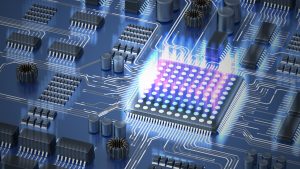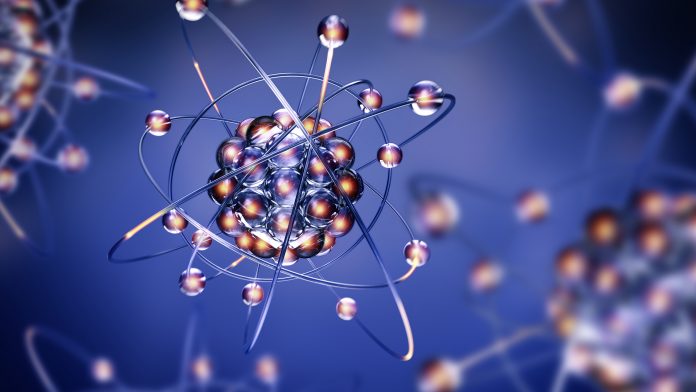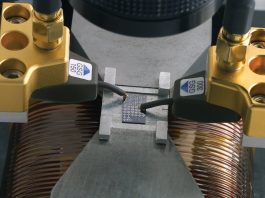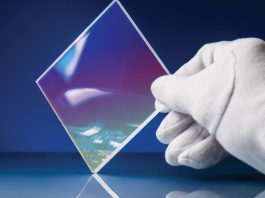EURAMET explains how European collaborative spintronics research is supporting future developments in electronics.
EURAMET European research projects are addressing the needs of industry through important developments in measurement science. These technical projects are accelerating the uptake of research results in many diverse areas, including the field of spintronics research. Spintronics is the science behind the magnetic technology that, for example, reads and writes data on the hard disk in your laptop. Smaller, faster, and more efficient electronic devices are a vital part of Europe’s economic growth and industrial innovation and could significantly contribute to aims for a reduction in CO2 emissions.
Spintronics, which uses a fundamental property, the intrinsic spin, of electrons to process information in a way that is analogous to charge in traditional electronics, holds potential to help meet such aims. From spin-based nanodevices that can combine computation with logic and non-volatile magnetic memory, to topologically protected spin structures that can effectively carry information; spintronics research offers scope for the development of energy efficient, next-generation electronic devices.
The European Association of National Metrology Institutes (EURAMET)
Researchers need robust measurement methods for reliably characterising fundamental quantum material properties as a precursor to introducing electron spin technologies into new applications. EURAMET’s collaborative research projects, each involving teams of scientists from multiple countries, are working in diverse fields of measurement science, or metrology, including spintronics and other quantum technologies.
EURAMET, the European Association of National Metrology Institutes, develops and disseminates an integrated, cost effective and internationally competitive measurement infrastructure for Europe – responding to the needs of industry, academic research groups, business and governments. To enhance the benefits of measurement to society, to enable a tangible impact that really makes a difference, is one of the highest priorities for EURAMET and its members. Measurement researchers collaborate to provide the high accuracy, low uncertainty measurements needed both now and in the future.
EURAMET’s European Metrology Research Programmes (EMRP and EMPIR) foster international collaboration, drive research excellence and address society’s grand challenges in areas including health, energy and the environment. So far, more than 300 joint research projects have brought together world-class measurement expertise in targeted projects to strengthen Europe’s position at the forefront of innovation and contribute to our economic prosperity.
Spintronics and quantum technologies at EURAMET
As an important field of applied physics that sits between conventional electronics and quantum mechanics, spintronics research makes use of the fundamental spin property of an electron to process information (see above). Quantum physics dictates that an electron possesses an intrinsic magnetic moment, the spin, that can either point ‘up’ or ‘down’. Spintronics utilises these two spin states (‘up’ or ‘down’) to represent zeros and ones in the same way that traditional electronics uses charge to relay binary data.
Notably, spintronics is considered to have key advantages compared to its conventional electronics counterpart, from the ability to store spin information robustly and permanently without the need of a continuous power supply, to the need for less energy to change a spin state versus generating an electric charge. These aspects make spintronic devices a particularly ‘green’ technology for data storage and data transfer applications.
Advancements in the field of spintronics have continually inspired the invention of ground-breaking new electronic devices for industry. In 2007, the discovery of giant magnetoresistance (GMR) was awarded the Nobel Prize in Physics – a significant milestone that is commonly regarded as the birth of modern spintronics. Soon after the discovery, scientists successfully realised the potential of electron spin for increasing the rate and density of information-processing from hard disk drives. As a direct result of this fundamental research, every hard disk and tape storage system available today uses a spintronic head to read data.
At present, innovative and radical new device applications continue to be developed by scientists working in spintronics, where interest is growing in magnetic technologies that can enable high-density, low-power data storage in highly localised fields. The collaborative power of European metrology institutions working under EURAMET’s research programmes have led to important contributions to magnetic technologies, as well as other areas like nanoscale electronics and material characterisation for spintronic devices. While magnetic technologies at the nanoscale offer promising applications for data storage, there is still a need to bridge existing knowledge gaps in the field. In particular, there is a need for reliable techniques to measure fundamental new phenomena like the spin-Seebeck effect – where the complex interactions of electron spin and thermal gradients have been only recently observed to generate spin currents, resulting from just a change in the temperature across a ferromagnet.

Projects
A research project completed in 2016, ‘Spintronics and spin-caloritronics in magnetic nanosystems’ (SpinCal), was instrumental in the development and analysis of magnetic nanodevices, helping to solidify an understanding of these interactions between electron spin and heat currents. Fundamental research under this particular project has led to new insight into the control and use of magnetic domain walls for operating electronic devices, as well as on a broader level, taking the first steps towards the creation of an underpinning measurement infrastructure for spintronic instruments.
Building on these achievements, further research in subsequent years under the project ‘Nano-scale traceable magnetic field measurements’ (NanoMag) has extended the accurate and traceable measurement of magnetic fields to micrometre and nanometre scales, harmonising magnetic field metrology across the globe and supporting the widespread adoption of best practises for spintronics measurements. These research efforts will support the innovation of energy efficient storage devices for ICT sectors, as well as providing biomedical scientists with more sensitive diagnostic tools for biosensing and molecular manipulation.
Since the completion of these projects, EURAMET has contributed to the further advancement of spintronics and related fields. Taking steps towards even greater data storage and device efficiency capabilities, projects such as ‘Metrology for topological spin structures’ (TOPS) have focused their attention on topologically-protected spin structures – materials with specific spin configurations that are more robust against external influences. The special topology of materials like this, that has drawn an international research spotlight, is present in the magnetic configuration which protects the electron spin arrangement, allowing for long-term and high-density data storage. On-going work under the EURAMET ‘TOPS’ project is making important strides in validating methods for characterising these materials – with the longer-term vision of aiding the development of new magnetic storage, spin-logic and microwave devices, as well as a new realisation of quantum standards that could revolutionise the landscape of measurement science.
European Metrology Network for Quantum Technologies
The revolutionary nature of quantum technologies holds both promise and risk for European industry and innovation. It is vital that Europe remains at the forefront of this new field, so that it can benefit from the technological advances whilst keeping society safe and secure.
Already, several companies – including the whole range of small, medium and large enterprises (SMEs) – have started to develop quantum devices or have begun to integrate them into their products. Standardisation and reliability are key elements for commercial success and progress in research and development.
Two years ago, in close collaboration with stakeholders, EURAMET launched the European Metrology Networks (EMNs) whose purpose is to analyse European and global metrology needs, and address them in a co-ordinated manner.
The networks provide a single point of contact for information, underpin regulation and standardisation, promote best practice, and establish a comprehensive, longer-term measurement infrastructure. The EMNs aim to create and disseminate knowledge, gain international leadership and recognition, and build collaboration across the measurement science community.
Quantum
One of these networks, the EMN for Quantum Technologies, is responsible for providing active co-ordination of European measurement science research to maintain competitiveness in the field of quantum technologies, including spintronics.
Ivo Pietro Degiovanni from INRIM, Italy’s National Metrology Institute, and Chair of the Quantum Technologies network, said: “The network aligns its activities with the objectives of the EC Quantum Technologies Flagship, and national and intergovernmental quantum technologies programmes. This ensures the consideration of metrological aspects and the transition of quantum research results into quantum-technology-based applications.”
The network focuses mainly on the research and innovation domains of the Quantum Flagship that have impact on metrology or present specific metrological needs that need to be addressed, such as quantum sensing & metrology, quantum communication, and quantum computing & simulation.
The contribution of the EMN for Quantum Technologies to standardisation and certification bodies within the quantum technologies area will importantly ensure the quality and worldwide acceptance of European products. Some examples of this are:
- In the area of quantum-secured communication, it is also crucial to engage with the relevant national security agencies to obtain their input on what is required for their standards assurance certification processes;
- For the distribution of atomic time, it is fundamental to define standards to facilitate the industrial take-up; and
- Innovative spin-based quantum sensors, as well as new materials and fabrication technologies – e.g. for detectors, integrated circuits, or spin systems – requires standardised characterisation techniques to certify their quality and reliability.
By engaging with stakeholders, the network is working to promote and facilitate knowledge sharing, collaboration and the uptake of measurement science in the development of quantum technologies – as well as co-ordinating the establishment of globally accepted measurement services for quantum technologies and devices.
Conclusion
EURAMET, its collaborative research projects, and its EMN for Quantum Technologies are actively supporting emerging quantum fields, including spin-based quantum technologies. Through important innovations in measurement science, EURAMET is providing the framework for scientists to exploit both the fundamental spin and electric charge properties of electrons – supporting the development of next-generation electronic devices that harness the laws of quantum physics for improved functionality and performance.
EURAMET is paving the way for measurement science communities around Europe, co-ordinating research efforts to ensure the region is able to maintain its global competitiveness in the field of quantum technologies.
Fiona Jones
Ayesha Pindoria
EURAMET
+49 531 592 1960
secretariat@euramet.org
Please note, this article will also appear in the second edition of our new quarterly publication.









